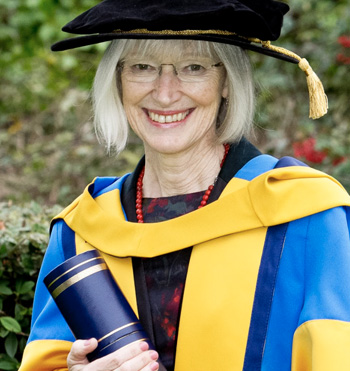Deborah Howard
UNIVERSITY COLLEGE DUBLIN
HONORARY CONFERRING
Monday, 1 December 2014 at 3 p.m.
TEXT OF THE INTRODUCTORY ADDRESS DELIVERED BY PROFESSOR KATHLEEN JAMES-CHAKRABORTY, UCD School of Art History and Cultural Policy on 1 December 2014, on the occasion of the conferring of the Degree of Doctor of Literature, honoris causa on Deborah Howard
President, Honoured Guests, Ladies and Gentlemen
 Architecture is the most public of all the arts, and the architecture of few foreign cities has influenced that of these islands as much as that of Venice. Deborah Howard has written extensively about Scottish architecture, but her reputation as the finest British architectural historian of her generation is due above all to the many books she has written about Venetian buildings, their intellectual context and their sources in the eastern Mediterranean. Meticulously researched, lucidly written, imaginatively argued, and beautifully illustrated, these have set a standard for scholarship that is also unusually accessible. Few architectural historians have a larger or more enthusiastic audience; even fewer have challenged as well as delighted their readers as much as Howard.
Architecture is the most public of all the arts, and the architecture of few foreign cities has influenced that of these islands as much as that of Venice. Deborah Howard has written extensively about Scottish architecture, but her reputation as the finest British architectural historian of her generation is due above all to the many books she has written about Venetian buildings, their intellectual context and their sources in the eastern Mediterranean. Meticulously researched, lucidly written, imaginatively argued, and beautifully illustrated, these have set a standard for scholarship that is also unusually accessible. Few architectural historians have a larger or more enthusiastic audience; even fewer have challenged as well as delighted their readers as much as Howard.
Howard was trained as a historian of Renaissance architecture, and her study of the relationship between a single sixteenth century architect, Jacopo Sansovino, his buildings and their patrons, launched her career as a scholar. While most architectural historians focus on a period, Howard has remained committed above all to a place. Her book, The Architectural History of Venice, first published in 1980, remains the standard work on the subject. And yet, as unique as that amazing city is, Howard has always been alert to the way in which its buildings are infused with ideas brought from elsewhere. Perhaps her most original work, Venice and the East: The Impact of the Islamic World on Venetian Architecture 1100-1500, assesses with unprecedented and unprejudiced insight the impact of Islamic architecture and urbanism upon this most exotic of European cities. Howard was one of the first architectural historians to recognize how easily people, goods, and ideas travelled already in the Middle Ages across what were already religious and have since become national boundaries. Named a notable book of the year by the New York Times, one of the many accolades Howard has enjoyed throughout her career, Venice and the East remains an exemplar of the global approach to history and art history that has flourished since its publication in 2000.
Nor is this the only way that Howard has expanded the horizons of architectural history. At a time when the humanities are often opposed to the sciences, Howard has repeatedly demonstrated in scholarship of unusual interdisciplinary breadth how much they can learn from one another. Married to the physicist Malcolm Longair, she collaborated with him on an important article on harmonic proportions in Palladio. More recently she worked with engineers, musicologists and musicians when with Laura Moretti she co-authored Sound and Space in Renaissance Venice: Architecture, Music, Acoustics, for which she brought the choir of St. John’s College Cambridge to perform in a dozen Venetian churches.
Howard wears her many honours lightly. An emerita professor at the University of Cambridge, she is a fellow of the British Academy and of the Royal Academy of Scotland. She has held a number of distinguished visiting appointments in Australia and the United States, as well as Europe. Her most recent book, Venice Disputed: Marc’Antonio Barbaro and Venetian Architecture 1550-1600, was researched in part during a visit to Harvard University’s Villa I Tatti, located just outside Florence. She has also generously accepted many invitations to Ireland.
Howard has long enjoyed a substantial Irish readership, drawn not least from those who appreciate the impact the lively detail of Venice’s Romanesque and Gothic filigree and the classical proportions of its Renaissance and Baroque structures have had upon centuries of Irish architects and builders. As gifted a teacher as she is a scholar, she has also inspired generations of Irish art and architectural historians for the grace with which she marries exemplary kindness with intellectual rigour. We honour her today for her broad-minded scholarship that breaks through cultural and disciplinary boundaries to identify how architecture becomes both beautiful and meaningful.
Praehonorabilis Praeses, totaque Universitas,
Praesento vobis hanc meam filiam, quam scio tam moribus quam doctrina habilem et idoneam esse quae admittatur, honoris causa, ad gradum Doctoratus in Litteris; idque tibi fide mea testor ac spondeo, totique Academiae.